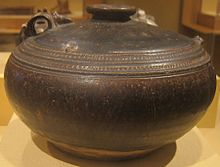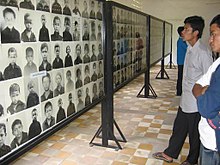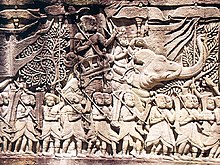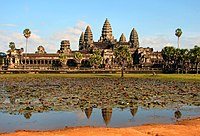History
Pre-history
There is sparse evidence for a
Pleistocene human occupation of present-day Cambodia, which includes
quartz and
quartzite pebble tools found in terraces along the Mekong River, in
Stung Treng and
Kratié provinces, and in
Kampot Province, although their dating is unreliable.
[24] Some slight archaeological evidence shows communities of
hunter-gatherers inhabited the region during
Holocene: the most ancient archaeological site in Cambodia is considered to be the cave of
L'aang Spean, in
Battambang Province, which belongs to the
Hoabinhian period. Excavations in its lower layers produced a series of
radiocarbon dates as of 6000 BC.
[24][25] Upper layers in the same site gave evidence of transition to
Neolithic, containing the earliest dated earthenware ceramics in Cambodia
[26]

Glazed stoneware dating back to the 12th century
Archaeological records for the period between Holocene and
Iron Age remain equally limited. A pivotal event in Cambodian prehistory was the slow penetration of the first rice farmers from the north, which began in the late 3rd millennium BC.
[27] The most curious prehistoric evidence in Cambodia are the various "circular
earthworks" discovered in the
red soils near
Memot and in the adjacent region of Vietnam in the latter 1950s. Their function and age are still debated, but some of them possibly date from 2nd millennium BC at least.
[28][29]
Other prehistoric sites of somewhat uncertain date are
Samrong Sen (not far from the ancient capital of
Oudong), where the first investigations began in 1875,
[30] and
Phum Snay, in the northern province of
Banteay Meanchey.
[31] An excavation at Phum Snay revealed 21 graves with iron weapons and cranial trauma which could point to conflicts in the past, possible with larger cities in Angkor.
[32] Prehistoric artefacts are often found during mining activities in
Ratanakiri.
[24]
Iron was worked by about 500 BC, with supporting evidence coming from the
Khorat Plateau, in modern-day Thailand. In Cambodia, some Iron Age settlements were found beneath
Baksei Chamkrong and other Angkorian temples while circular earthworks, were found beneath
Lovea a few kilometres north-west of Angkor. Burials, much richer than other types of finds, testify to improvement of food availability and trade (even on long distances: in the 4th century BC trade relations with India were already opened) and the existence of a social structure and labour organisation. At Phum Snay, burial goods included weaponry and skeletons showed evidence on trauma inflicted by violence, indicating warfare between different groups in the area as a result of its strategic location for trade.
[27][33]
Also, among the artefacts from the Iron Age, glass beads are important evidence. Different kinds of glass beads recovered from several sites across Cambodia, such as the Phum Snay site in northwest and the Prohear site in southeast, show that there were two main trading networks at the time. The two networks were separated by time and space, which indicate that there was a shift from one network to the other at about 2nd-4th century AD, probably with changes in socio-political powers.
[34]
Pre-Angkorian and Angkorian era[edit]
During the 3rd, 4th, and 5th centuries, the
Indianised states of
Funan and its successor,
Chenla, coalesced in present-day Cambodia and southwestern Vietnam. For more than 2,000 years, what was to become Cambodia absorbed influences from
India, passing them on to other Southeast Asian civilisations that are now Thailand and Laos.
[35] Little else is known for certain of these polities, however Chinese chronicles and tribute records do make mention of them. It is believed that the territory of Funan may have held the port known to Alexandrian geographer
Claudius Ptolemy as "
Kattigara". The Chinese chronicles suggest that after Jayavarman I of Chenla died around 690, turmoil ensued which resulted in division of the kingdom into Land Chenla and Water Chenla which was loosely ruled by weak princes under the dominion of
Java.
The
Khmer Empire grew out of these remnants of Chenla becoming firmly established in 802 when
Jayavarman II (reigned c790-850) declared independence from
Java and proclaimed himself a
Devaraja. He and his followers instituted the cult of the
God-king and began a series of conquests that formed an empire which flourished in the area from the 9th to the 15th centuries.
[36] During the rule of
Jayavarman VIII the Angkor empire was attacked by the
Mongol army of
Kublai Khan, however the king was able to buy peace.
[37] Around the 13th century, monks from
Sri Lanka introduced
Theravada Buddhism to Southeast Asia.
[38] The religion spread and eventually displaced Hinduism and Mahayana Buddhism as the popular religion of Angkor; however it was not the official state religion until 1295; when
Indravarman III took power.
[39]
The Khmer Empire was Southeast Asia's largest empire during the 12th century. The empire's centre of power was
Angkor, where a series of capitals were constructed during the empire's zenith. In 2007 an international team of researchers using satellite photographs and other modern techniques concluded that Angkor had been the largest pre-industrial city in the world with an urban sprawl of 1,150 square miles (2,978 square kilometres).
[40] The city, which could have supported a population of up to one million people
[41] and
Angkor Wat, the best known and best-preserved religious temple at the site, still serve as reminders of Cambodia's past as a major regional power. The empire, though in decline, remained a significant force in the region until its fall in the 15th century












